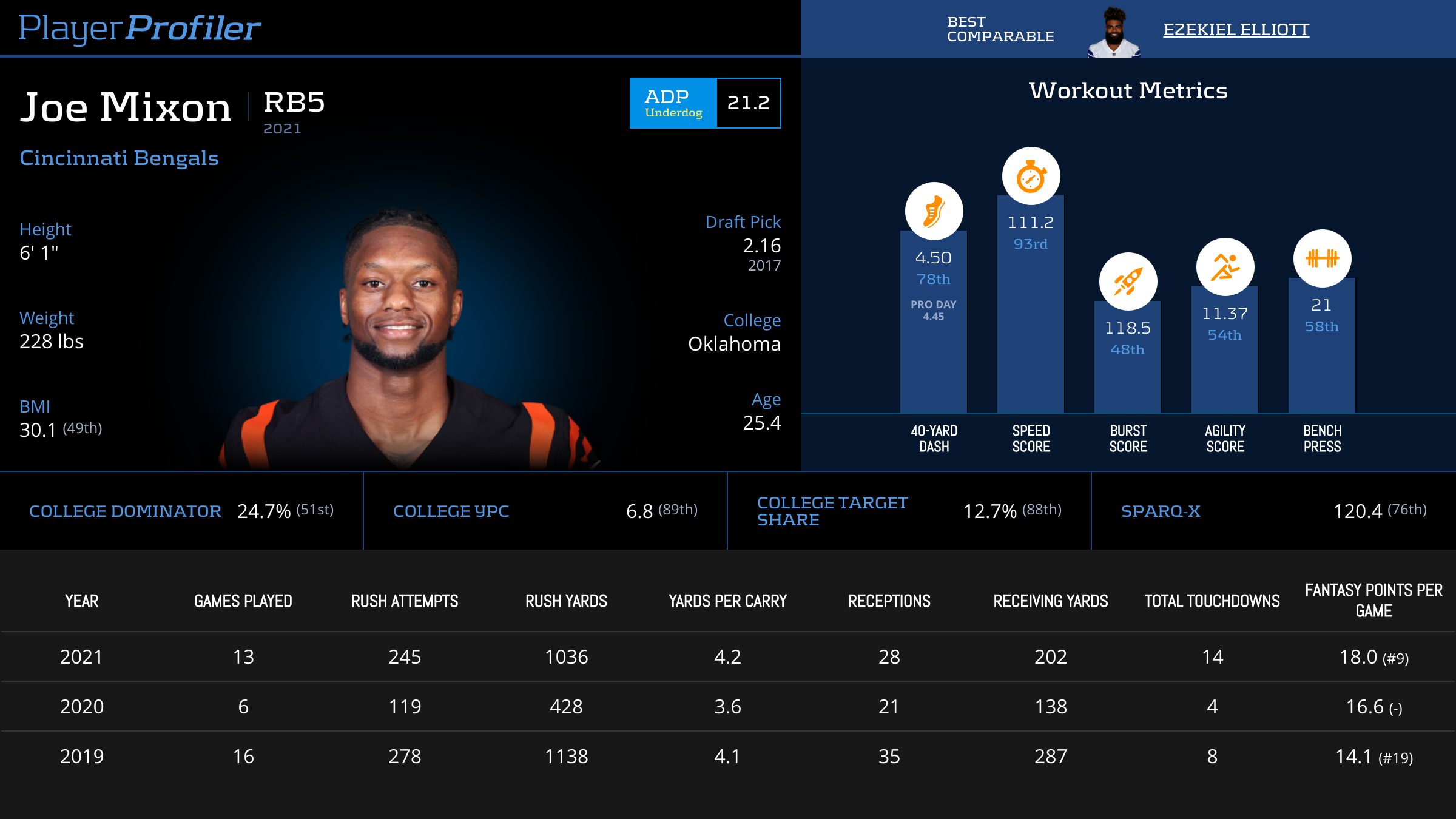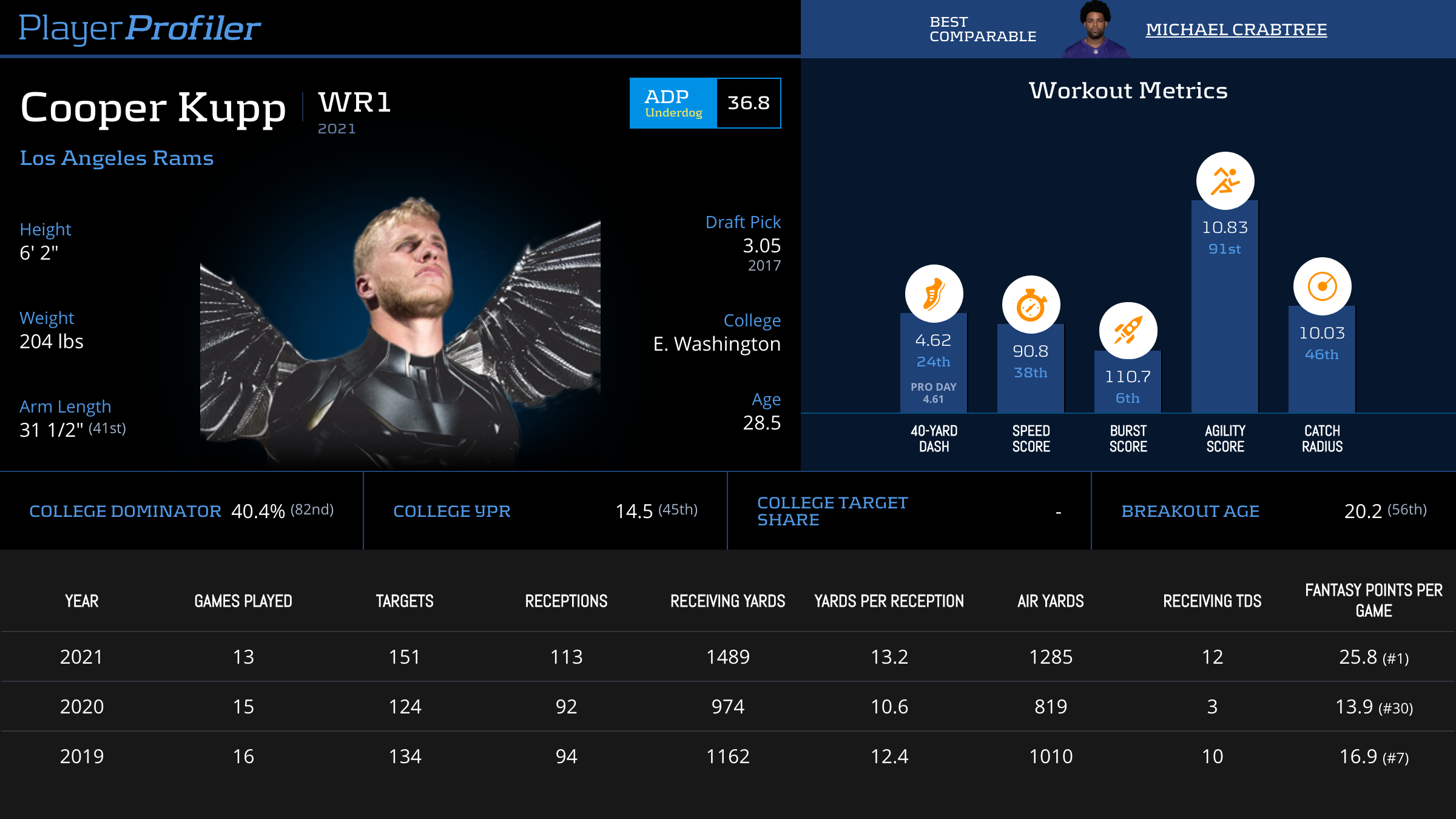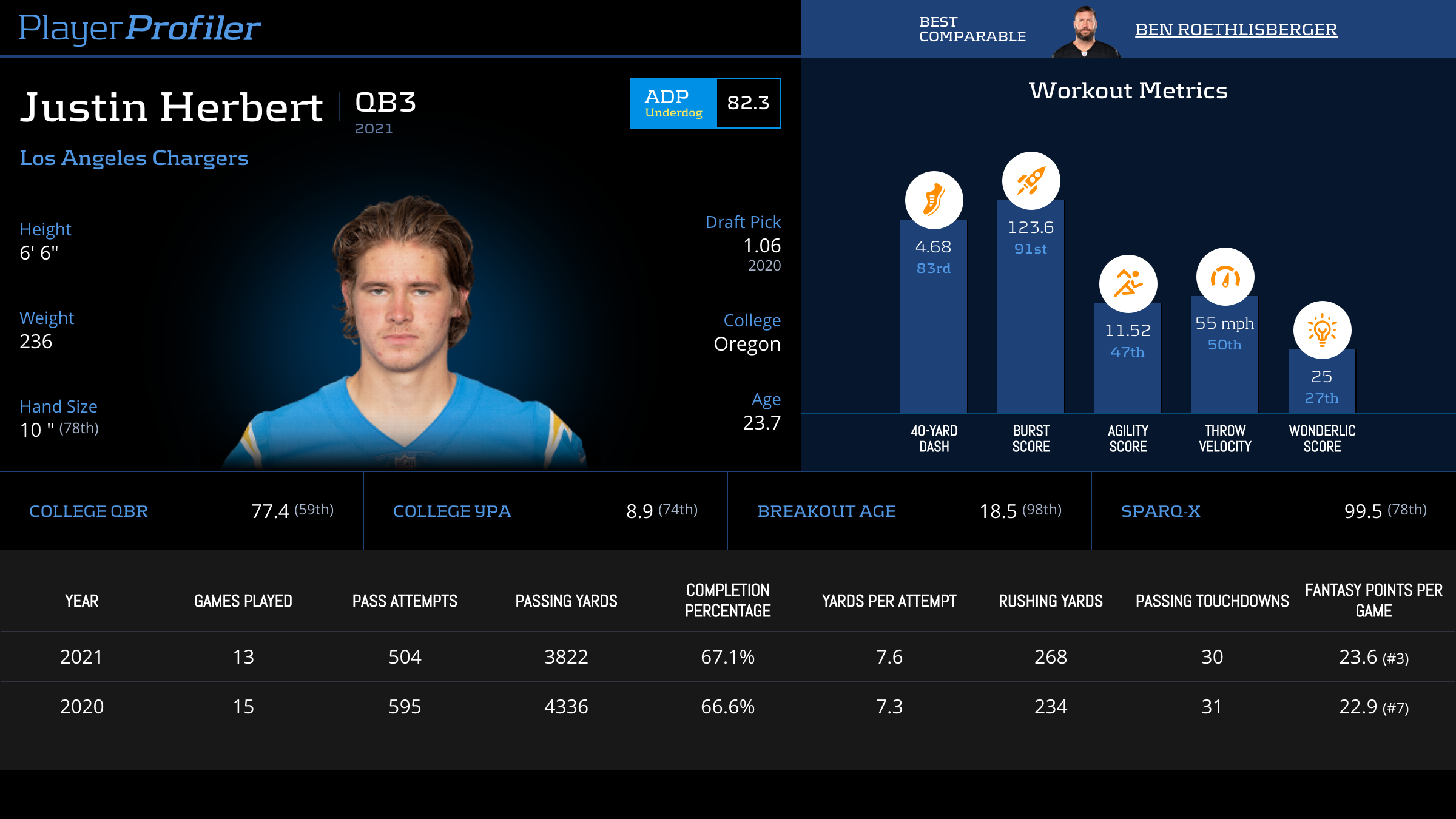There are a few reasons why you’re already playing playoff best ball tournaments:
1) Your season-long hopes are dashed and it’s time to focus on something new
2) You just can’t pass up more ways to bet on football
3) You want to take advantage of unique constructions that can only come given the uncertainty of pre-playoffs drafting
In this piece, I will cover general strategy for playoff best ball with a special eye toward maximizing the edge available from drafting early. This article focuses primarily on structural drafting strategies, and I will follow up with my favourite player and team values later this week.
What is the Dominant Strategy in Playoff Best Ball?
I will tailor my analysis to Underdog’s The Gauntlet; but you can adjust the strategy for the specifics of any similarly structured tournament. The Gauntlet consists of four rounds. Each of the first two have roughly one-in-six advancement odds, with a one-in-fifteen conference championship round and a final 94 team play down for the grand prize. Your team is 10 players deep, each week starting one quarterback, 1 running back, two pass catchers and a flex.
Similar to off-season best ball tournaments, the prize pool is extremely top heavy with 20-percent of the money going to first place and over half awarded in the Super Bowl week. Essentially, in order to make positive expected value lineups you have to prioritize your equity to make the Super Bowl and be live to win it all once there.
The Inflection Point
Offseason best ball debates raged on about whether maximizing advancement or ‘super-teams’ was a stronger strategy. While this divide played out on the margins, it is front and centre in playoff best ball.
In order to have any chance to take first place you need at least five active players in the Super Bowl. This incentivizes stacking your lineups to consolidate around few teams you hope go deep. However, an aggressive stacking strategy has trade-offs. If you prioritize two elite contenders (for example, Packers and Chiefs) you will be selecting poorly-projected depth players to round out your team. Your first-round competitors can draft studs on potential wild card teams such as Ja’Marr Chase or Dalvin Cook while you’re locking in Byron Pringle.
On the contrary, you could build your second stack primarily around a team with later ADPs such as the Ravens, 49ers, or Titans. This allows you to lock in correlated studs at each round of your draft, but you may decrease your odds of your stack advancing deep into the post-season.
Then there’s the third door: you build two early, shallow stacks while focusing your later picks on high-upside players selected to help you advance through the early rounds. In the remainder of this article, I will walk through each of these approaches and identify my preferred option.
Knowing the Odds
Using fivethirtyeight projections, eight teams currently have a 94-percent or greater chance to make playoffs. Among those, the Packers and Chiefs are both favoured for a first round bye with New England, Tennessee and Dallas all above a 10-percent chance to land one.
Baby Bye, Bye, Bye
The inclusion of two first round byes adds a layer complication to the strategy. If you stack both bye-teams you are virtually drawing dead to advance past round one, with even one bye-stack hurting your odds.
In terms of pure game-maximization, the Patriots, Buccaneers, Rams, Titans, Cardinals and Cowboys have the best blend of being assured of playoffs, and likely to be in your wildcard weekend lineups.
These are all teams I want to be over the field on; especially the Cowboys, Titans, and Buccaneers who are virtually locked into home playoff games.
Initially, my contrarian pre-disposition had me planning to target teams with high bye equity. Those teams should have more unique pieces to advance into later rounds due to the additional hurdle to advance from round one, and historically have the best chance to make the Super Bowl. However, the market has seemingly no concerns regarding the bye. Davante Adams, Tyreek Hill, and Travis Kelce all have first round average draft positions (ADP). Patrick Mahomes and Aaron Rodgers are the second and third quarterbacks off the board, while Aaron Jones and Clyde Edwards-Helaire both selected as top five running backs.
I would be stunned if this remains the case in drafts taking place after seeds have been officially awarded. In order to maximize the value of my portfolio, I plan to be under-weight on these teams in early drafts, and make up the gap in late drafts if their ADP slides downward upon clinching a bye.
Playoffs?!?!
On the other side of the coin, we have a wide-open playoff race. The Bills, Chargers, 49ers, and Colts all have between 70-89-percent odds of making playoffs. The Colts and 49ers have both dramatically improved their odds of late and you should take advantage before their ADP fully reflects this. Jonathan Taylor is the only Colt with an ADP in the top 50. Deebo Samuel has risen substantially into the fourth round, but he and George Kittle are likely to rise further. Brandon Aiyuk and Elijah Mitchell are still available in the last rounds of your draft.
Among the remaining teams we should expect two to three to be playing on wild card weekend. Here are your candidates with at least 10-percent odds:*
Ravens – 56%
Saints – 50%
Bengals – 49%
Eagles – 38%
Vikings – 31%
Steelers – 17%
Browns – 15%
Raiders – 10%
Football Team – 10%
Dolphins – 10%
*Article drafted prior to Monday and Tuesday games; odds will be updated following game results.
The star players on each of these teams are virtually free with none carrying an ADP in the first six rounds. While risky, if you’re looking for a unique edge only available to early drafters these are the teams I would target late. However, if I’m going to do it I would rather do so to an uncomfortable degree.
If you’re Taking Risks, Bet the House
Simply taking Joe Mixon in the seventh round does not serve much of a purpose. In order for that decision to pay off, you essentially need Mixon to play one-two games, providing elite fantasy production while playing to help you advance with your primary stacks. There are several flaws with that approach.
Targeting Mixon as a ‘one-off’ is most helpful if you are expecting a large chunk of your team to be on bye in week one, and you need to maximize points late. However, keep in mind players tend to score more fantasy points in wins than losses – especially running backs.
As well, if the Bengals go on a run to the AFC Championship, a team drafting late – after Cincinnati clinches a playoff spot – who has built a Bengals stack has an edge over your Mixon lone ranger. This creates a very narrow window of utility for Mixon to help you win, and it involves him being eliminated before you play for the big bucks.
If I’m targeting any of these teams, I want two players minimum, such as Mixon + Ja’Marr Chase or Tee Higgins, or Dalvin Cook + Justin Jefferson. The Bengals and Ravens are my preferred options due to the increased volatility of the AFC, and their high ceiling playmakers.
Stacking: Concurrent or Subsequent?
The most interesting strategic point is not whether to stack – this should be obvious – but how to build your stacks.
I call concurrent stacks those that are built in alternating fashion among two high-value teams. For example, the following start:
R1: Tyreek Hill
R2: Mike Evans
R3: Tom Brady
R4: Clyde Edwards-Helaire
This type of open can either focus deep on the Buccaneers and Chiefs including their ancillary pieces, interchange one-offs from other teams to balance out your bye equity or build a late stack on an uncertain playoff team.
The other model of stacking is subsequent stacking. Essentially, this involves blitzing one elite team’s options early in the draft, while focusing your secondary stack entirely on a mid-value team, with similar options for your late picks. For example:
R1: Tyreek Hill
R2: Travis Kelce
R3: CeeDee Lamb
R4: Clyde Edwards-Helaire
R5: Amari Cooper
R6: Dak Prescott
This is my preferred method of team building. It is the only path at building the plausibly optimal stack of three separate teams. (Let’s say I add in a late stack of the Ravens). In the first example, you are submitting to the reality you do not have the best stack of the Chiefs, or the Buccaneers, and thus your win condition is a KC-TB Super Bowl with the hope your combination is the highest scoring among those constructions.
Why Subsequent Stacks are my Win Condition
Subsequent stacking allows for more flexibility of win condition. I am tied to the Cowboys as the NFC Super Bowl representative, but could feasibly have the optimal stack of either the Chiefs or Ravens alongside my Cowboys in the Super Bowl. The Chargers, Titans, and Ravens are great options for mid-late round stacks on the AFC side. The Cowboys, Cardinals, and 49ers are excellent choices on the NFC side.
The other benefit of this approach is a higher advance equity in early rounds by drafting a higher caliber of player in all rounds. The greatest risk to any correlated team is losing round one before the benefits of team correlation are maximized, only to watch your stacks play in the Super Bowl and have nothing to show for it. This strategy marries a live win condition in the Super Bowl with high advance odds early.
The drawback is your win condition depends on a team making the Super Bowl the market has determined has fairly low odds to do so. However, I would prefer to make a low-probability bet with a high-probability of paying off, than prioritize an amalgamation of higher-probability bets. Play a wide enough portfolio with this structure and you increase your odds one of the teams you build around hits. Given the turbulence of the COVID-ravaged NFL and the lack of separation among playoff teams’ performance this year, 2021 projects as a uniquely strong year to back an underdog.
Mechanics of Drafting
You are essentially locked into a prisoner’s dilemma with your league mates. It is in each party’s best interests for all drafters to focus on different stacks and allow each team the chance to build the most live team possible. However, early in the draft is the hardest time to mark your territory. Especially among the Buccaneers and Chiefs, so many options go so early it is hard to know if you will be able to optimize your stack. If you take Tyreek Hill at the 1.03, you are taking on a lot of risk another drafter selects Travis Kelce and Patrick Mahomes before your next pick.
For that reason, my preferred option in the early fist is Cooper Kupp whenever available.
The Rams won’t have a bye, and all remaining Rams options last until the mid-rounds. If you can lock up Kupp in the first, it is likely you can chose another team’s pairing in rounds two and three, while filling out your Rams stack in the fourth and fifth rounds. A hidden benefit of my ‘subsequent’ stacks idea is the intent to blitz one team with such aggression you make it sub-optimal for any other team to compete with you for that stack.
As well, I prefer to leave my quarterback for later in the draft, especially those who are attainable with ADPs well after most of their weapons.
In a recent draft, I was able to secure five combined Cowboys and Chargers prior to Dak Prescott or Justin Herbert being selected. I was comfortable taking only Prescott, but because I already rostered Austin Ekeler, Keenan Allen, and Mike Williams, the rest of the room had no reason to select Herbert. He remained on the board until Round 9, at which point I happily added him to the team.
Roster Construction
Both 1QB and 2QB builds are viable. If your quarterback’s team is unlikely to receive a bye, you are reliant on them playing four games to win the tournament anyhow. Given you likely drafted three of his skill players, it is reasonable to say your team is so reliant on him having strong fantasy production each game, pairing him is redundant. However, it comes down to a cost, benefit analysis. If you take an early quarterback, 1QB is almost mandatory to justify the opportunity cost. If you wait until round six and eight to select your pivots, you can afford two. In this scenario you spent more capital on running back and pass catcher (WR/TE) leaving less necessity for depth.
I would approach teams with one spot reserved for quarterback, two for running back and five for WR/TE. Use your remaining two picks on any positions most likely to add utility to your team.
In terms of stacks, I would hard cap exposure at four teams (ideally your four conference finalists). I have built three team and four team builds dependent on the flow of the draft. I would not draft any player unless you can pair them with a team mate, and I’d want minimum three, ideally four, players on the team with my quarterback(s).
And Now, a Word about ZeroRB…
It just wouldn’t be a Jakob Sanderson article if I didn’t add in a note about running back fragility. As with early summer best ball drafts, the largest risk factor in early drafts is the prospect of injury. It can also be the largest edge if you select a beneficiary of injury.
We know running backs are more likely to suffer an injury than receivers, and more importantly we know running backs receive a greater benefit if a starter in front of them gets hurt. Especially if you are drafting heavy favourites with few high-value players remaining by late rounds, prioritize their backup running back with your final pick.
What if Edwards-Hellaire gets injured before the end of the season? What if the Leonard Fournette injury is more serious than anticipated? What about James Conner? Ezekiel Elliott? Where would their backfield mate be drafted after an injury?
One need only look back to last year when Fournette was a late-round pick and playoff tournament MVP. Given the COVID-19 environment, the appeal of backup running backs will apply at all times.Nonetheless, it is especially poignant with three games to play and opportunities to select players late who may wind up early round selections two weeks from now.
The Final Word
Have fun drafting your playoff best ball teams! Adopting the strategic advice in this series won’t assure you success in a tournament this random. But it can help you draft only lineups with the requisite ceiling to take down the grand prize should fortune smile on you.







